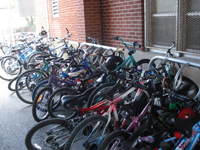Investing for short- and long-term health gains
CLASP projects demonstrate early return on investment by supporting communities to be healthier
July 9, 2012
 Investing in cancer and chronic disease prevention isn’t all that different from investing in financial markets. Most advisors would recommend focusing on long-term gains and ignoring minor market fluctuations, particularly in these roller-coaster economic times. After all, it can take years, if not decades for an investment to yield results, particularly when investing in such things as access to healthy food choices or active modes of transportation.
Investing in cancer and chronic disease prevention isn’t all that different from investing in financial markets. Most advisors would recommend focusing on long-term gains and ignoring minor market fluctuations, particularly in these roller-coaster economic times. After all, it can take years, if not decades for an investment to yield results, particularly when investing in such things as access to healthy food choices or active modes of transportation.
So when the Canadian Partnership Against Cancer and its funding partners, the Public Health Agency of Canada and the Heart and Stroke Foundation, invested a total $15.5 million in seven different Coalitions Linking Action and Science for Prevention (CLASP) projects, one of the challenges was to balance the long view with the short view.
With the initial 2.5-year funding window now complete, it has been an opportune time to take stock of successes and learnings of each of the seven projects, which collectively brought together more than 60 organizations to collaborate on addressing risk factors common to many chronic diseases. The bottom line? CLASP is a solid investment, with the seven projects having already brought about positive changes to promote health and wellness and pointing to the potential for long-term success and impact.
One example is the Healthy Canada by Design project, which aims to support the design and development of communities that promote physical activity. In Peel Region, just one of the many jurisdictions across Canada currently involved in the project, eight policies have been amended so the project’s Health Background Studies Framework can be more readily applied to help promote walking, biking and other forms of physical activity in the design of the region’s communities. Similarly, the Collaborative Action on Childhood Obesity project played a role in Wapekeka First Nation’s decision to ban the sale of all energy drinks in the community.
Networking, collaboration and knowledge exchange have been central to the success of all seven CLASP projects. One of the most powerful examples is the HEY initiative, which has developed a unique cancer and chronic disease prevention curriculum that both respects and reflects First Nations culture. Development of the curriculum was led by the Federation of Saskatchewan Indian Nations, which actively engaged First Nations peoples to ensure culturally responsive information and collaborated with national and provincial health organizations on the content. This approach has proven to be a compelling and effective model for organizations to continue collaborating with First Nations communities on health-related initiatives.
There is also evidence that CLASP is going beyond policy changes to drive healthier behaviours within communities. Of 72 schools participating in the evaluation of the Children’s Mobility, Health and Happiness project, results demonstrate that 30 schools saw an increase in walking to school, 36 schools saw a decrease in driving to school, and 18 schools saw an increase in biking to school. Based on a series of reasonable assumptions, the University of Toronto has calculated that simply sustaining this behaviour change could add 6.4 million minutes of walking among students and prevent 427,880 vehicle kilometers travelled annually.
Another aspect of the Children’s Mobility, Health and Happiness project explores sustainable happiness – defined as happiness that contributes to individual, community and/or global wellbeing and does not exploit other people, the environment, or future generations.[i] Through the connections created through this CLASP project, a class in Nunavut has developed a video to celebrate sustainable happiness.
To build on the successes of CLASP to date, workshops will take place in September and October 2012 to engage the environmental and clinical communities in opportunities for a new round of CLASP funding. In addition, existing CLASPs had the opportunity to apply for continued funding.
Notes
i http://www.sustainablehappiness.ca/, accessed July 5, 2012
